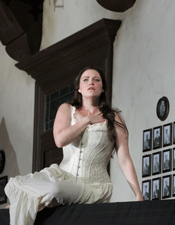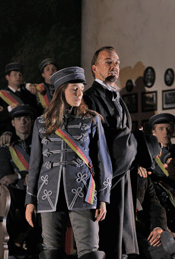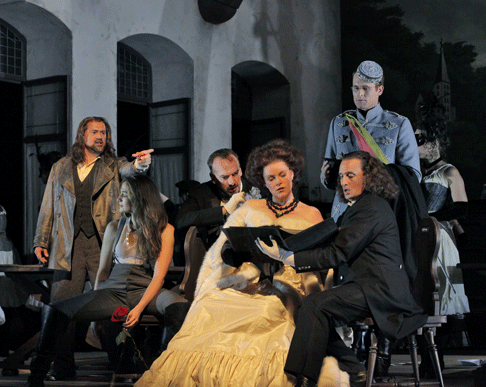22 Jul 2010
Hoffmann Takes A Hit In Santa Fe
Despite its length and pretentions to being serious opera, Jacques Offenbach’s The Tales of Hoffmann, dating from the 1880s, remains a leaky vessel adrift on a sea of self-fulfilling prophesies of doom.

Despite its length and pretentions to being serious opera, Jacques Offenbach’s The Tales of Hoffmann, dating from the 1880s, remains a leaky vessel adrift on a sea of self-fulfilling prophesies of doom.
While gifted with some lovely melodic writing and opportunities for grand operatic singing, the story of a depressed alcoholic poet (“he never drinks water,” one line has it), and his tales of futile amorous adventure often seem over-stuffed with dialogue and redundant action. This opera is expensive and difficult to produce, and in the end bears only a negative message.
Just what Hoffmann’s message is has long been a subject of discussion. My view is that once the pretty surface of melody and musical charm is peeled back, below lies only vegetable cellulose, or nothing much. Some will argue that romantic fantasy is at the core of the piece; others find 19th century existential angst; Richard Wagner condemned it for a lack of “moral” value. I would tend to express it more in terms of the bad psychology of a neurotically disturbed man who through the confusions of alcohol and dissipation dooms his own romantic ambitions. However any of that may be, it is best to take Hoffmann as an exercise in visual pleasure and melodic delight — if there are singers and producers to make it happen, and a producer and music director to give it a light and stylish touch.
 Erin Wall as Antonia
Erin Wall as Antonia
In Santa Fe Opera’s heavy-handed production, the show turned out to be
badly cast and suffocatingly over-produced. None of the singers was adequate to
the task at hand; the voices were minor or flawed. The leading tenor, Paul
Groves, the key figure in the opera, who looked and played well, seemed to have
no upper register and was often short on volume. Professional that he is,
Groves soldiered through, but he was far from the real thing, in this most
lyrical of big French tenor parts.
Canadian soprano Erin Wall assumed the neigh-impossible task of singing the three major soprano roles the opera requires, the coloratura doll of Act I, Olympia, the lyric soprano of Act II, Antonia and the soprano or mezzo part of the Venetian courtesan, Giulietta, in Act III. She did not have the light agility or highest tones required by Olympia, as Santa Fe’s management must surely have known, and thus it seems a decision was made to turn her Olympia into Gilbert & Sullivan camp — if she did not have the clean runs or pin-point high notes, well mark it up to technical difficulties in her manufacturer Spalanzani’s design. All in good fun? Ho hum. In later acts Wall fared better, and demonstrated a solid top, through high-C, as Antonia though not much tonal allure or play of color; her voice seemed to thicken under pressure, which was much of the time. As an actress Wall was never more than bland.
 Kate Lindsey as Nicklausse, Wayne Tigges as Councilor Lindorf and Students
Kate Lindsey as Nicklausse, Wayne Tigges as Councilor Lindorf and Students
The only other singer I will address now is the bass-baritone Wayne Tigges,
a last minute replacement for an ailing colleague in the all-consuming and
vocally demanding roles of Offenbach’s four villains, who are in every
scene, with much to sing, and comprise the engine that drives the thrust of
“evil” though the show — that is quite aside from demon rum.
Tigges proved a boy sent to do a man’s job, and while earnest and
hard-working he did not have the magnetic personality or force or maturity of
voice to claim the part. He needs coaching in menace with John Malcovich.
With an inadequate tenor and bass, and soprano who was short on stage charisma and vocal interest, Offenbach’s score was not well-served. I have to say, and am sorry to do so, that Stephen Lord, music director of Opera Theatre of St. Louis, was a cut-and-dried conductor in the pit. While his orchestra played well enough, far too often Maestro Lord’s direction lacked vitality, dragged where it should have sparkled, left dead moments and, in general, lacked shape, flow and accent. Disappointing.
Now we come to Santa Fe’s stage producer, one of the most famous bad-boys of opera, Christopher Alden — who fully lived up to his reputation. I am going to keep this short — who needs a list of horrors? Alden’s direction was everywhere fussy and mannered, secondary characters moved in slow motion, slithered across the stage floor, pranced about their heads in picture frames, joined hands in a merry trio of dancing — and so on, endlessly. In the final moments of Act II, gilded high-style Second Empire opera boxes emerged from stage right holding an audience eager to applaud the diva Antonia, who had expired moments before. Ah so! We were watching a play within a play (who knew?) — and the Second Act, which Offenbach had already provided with an unnecessary anti-climax following Antonia’s death, offered yet another development as Antonia arose from the dead and took her bows. Now, let’s see, where did that plot go?
 Paul Groves as Hoffmann, Kate Lindsey as Nicklausse, Wayne Tigges as Captain Dapertutto, Erin Wall as Giulietta, David Cangelosi as Pitichinaccio and Darik Knutsen as Peter Schlémil (standing)
Paul Groves as Hoffmann, Kate Lindsey as Nicklausse, Wayne Tigges as Captain Dapertutto, Erin Wall as Giulietta, David Cangelosi as Pitichinaccio and Darik Knutsen as Peter Schlémil (standing)
Costumes? Elegant, lavish with Victorian flounces, bustles and ruffles everywhere. Set? Not bad, actually: it all transpired in Luther’s Tavern, a high handsome room with five massive beams across the ceiling, a dark wood dado around the room and white plastered walls that showed off various plaques and hangings. Platforms with minimal trappings for scenes following the Tavern’s opening one (the Kleinsach scene), were brought in and out; they proved effective, and in the Venetian scene featured a massive painting in the style of Turner depicting the grand canal. It worked!
Maybe we will write more about all this later in the season; these things have a way of ripening, and several of the secondary players deserve attention for some were excellent. For now SFO’s Tales of Hoffmann is a game hardly worth the candle.
© 2010 James A. Van Sant/Santa Fe